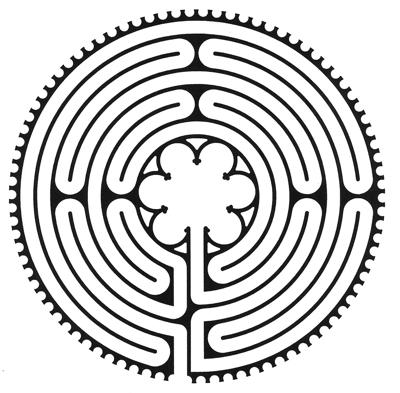
Labyrinth on the floor of the Chartres Cathedral, France
The pleasurable precision Umberto Eco used to design a labyrinth in
The Name of the Rose points towards a newly awakened passion in
art: discovering rules which structurize what seems to be chaos.
"Unpredictability and stringency" are the two main ideas
present in the work of Karlheinz Essl, a Viennese musician born in
1960. Since in everyday life things that used to be regarded as simple
became complicated, science was encouraged to look into the order of
chaos. In doing so, a unique aesthetic beauty was discovered in the
unfathomable, as can be seen in fractal computer illustrations of the
Mandelbrot set.
Essl, too, creates confusing acoustic landscapes, jumbling a handful of musical characters in order to "take the listener by the hand and show him something beautiful". The way through the labyrinth does lead out again: its convolutions are, however, unpredictable - even for the composer himself.

Labyrinth on the floor of the Chartres Cathedral, France
At the Conservatory in Vienna, Essl studied double bass with Heinrich
Schneikart and composition with Friedrich
Cerha. He played the bass with various jazz ensembles and
experimental groups where he was able to nurture his love for
"unpredictability". At the same time he studied musicology and made his
thesis on Anton Webern's Idea of
Synthesis (1989). The serial technique interested Essl not so
much for its "strictness" (as it is often misunderstood), but for the
way sound is regarded as a multi-layered sum of parts which can be
isolated.
Essl has continued to break music down to its components. In his recent works he has created specific sound types from the available instruments which can be seen as pre-musical bones. They are joined together during the course of the composition to form a skeleton, as in his orchestra piece In Girum. Imus. Nocte (1991). In joining this rudiments, Essl orients himself by the serial stringency: his main working tool is a computer which aids him in formalizing the musical processes. While considering the tectonic input Essl feed it, the computer draws up the skeleton of a composition which is predicated upon labyrinthine dimensions and ramifications. The sound types are combined, distorted, blown up, layered a system no one can break down once the score is finished.
Nevertheless Essl knows the way through the labyrinth. In constant dialogue with the computer he interprets not only his instructions concerning the sounds but also gets across his own ideas of what the piece should sound like. Even if the computer's language forces Essl to come to the point with what he thinks the piece should sound like even beyond the limits of mental facilities - it will not take control.
Essl's music, like all music, resembles language. The types of sounds are language techniques; the computer carries out the syntax and Essl forms the words. In the labyrinth of grammar, whoever wants to understand what these words mean will get lost. Just since music resembles language does not necessarily mean the vocabulary has to mean anything. There is no sound which could stand for something else.
Jean-Francois Lyotard was speaking for art in general at the end of the century when he said, "Nothing can be replaced, no substitution is justified or anyone is". Musical language as Essl understands it is a meta-language whose meaning is discovered by those who find the order in the sounds and allow themselves to be fascinated by the incomprehensible. The negotiation of this order is the Ariadne's thread of Essl's music which the composer holds firmly in his hands.
in: Booklet zur CD ARTSAT (ORF
1991)
Dr. Christoph Becher (* 1963 in Hessisch Lichtenau) studierte Musik-, Politik- und Literaturwissenschaften an der Universität Gießen. Er promovierte 1997 mit einer Dissertation über Alexander Zemlinskys Variantentechnik. Dramaturg am Wiener Konzerthaus, danach leitender Dramaturg an der Hamburgischen Staatsoper. Derzeit geschäftsführender Intendant des Württembergischen Kammerorchesters.
| Home | Works | Sounds | Bibliography | Concerts |
Updated: 13 Aug 2021